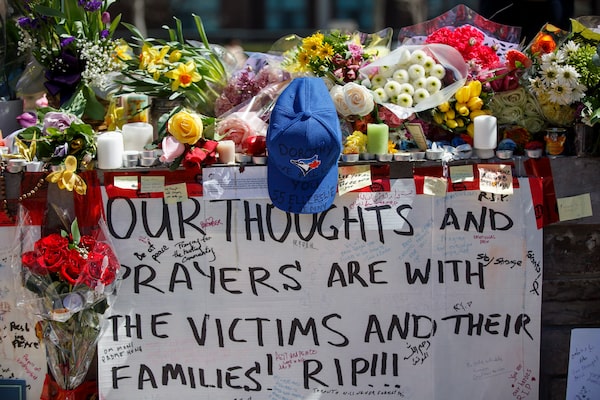The Globe and Mail wasn’t the first media outlet to report the number killed in Toronto’s Monday van rampage. It wasn’t first to report the name of the suspect or the first to report on a Facebook page purportedly operated by Alek Minassian that referred to dark online forums used by trolls and violent misogynists.
What is important when key details are changing or not confirmed, is being right, not being first.
When a catastrophe happens, it is chaotic. News and rumours, true or not, come through social media, other news sources, witnesses and official sources based on limited and at times contradictory information. Initial reports said several were killed, then four, then nine (a tenth died later in hospital). Without official confirmation of the number, the initial stories correctly said several were killed.
There was also confusion about the name, whether it was Alex or Alek Minassian, so caution prevailed and it didn’t take long to get confirmation of the correct name. And on the question of the Facebook post, it was better to wait until Facebook confirmed the “incel” (involuntary celibacy) post was from Mr. Minassian’s account.

Members of the public have set up multiple tributes to the victims of Monday's deadly van attack.COLE BURSTON/The Canadian Press
Some witnesses tried to guess his ethnicity, but that was not included in any coverage because it is not known. Police also quickly said the attack was not linked to terrorism. A former New York police commissioner told MSNBC news that the suspect was known to Toronto police, but that statement was also not included in any articles because it was not confirmed by Toronto police and turned out not to be true.
While journalists want to be quick and give the readers as much information as possible, it can be risky to report without checking because a falsehood can stick in people’s minds and is hard to be undone, especially with a detail that confirms a personal bias, such as the suspect’s race or religion.
This doesn’t mean the coverage was perfect. In the rush, mistakes were made. An incorrect link to a GoFundMe page was briefly online, as well as an incorrect victim’s name. A reader and a non-editorial staff member caught these mistakes and alerted editors quickly.
I’ve heard from a few readers upset with aspects of the coverage. Several believed it was wrong to show the orange body bags in Tuesday’s paper. The front page photo was an overhead shot showing two body bags and first responders working on the sidewalk. But it was a responsible choice because it showed what had happened – that people died – without being gratuitous.
Some also object to naming the suspects, believing they are looking for publicity. But while you should focus on the victims and the loss of their lives, the suspect is part of the story. You cannot understand why it happened without a look into the suspect and his motivation. I think the balance on this has been right and there have been very few references to him in headlines and limited photos.
One reader wondered why there was reference to mental-health issues.
The print headline referred to a description of him as “very shy” and also noted that he had posted misogynistic views on social media and praised a U.S. mass murderer. The focus of the article was on his social-media posts and included his time in Canadian military basic training as a Canadian Armed Forces recruit. The article also included interviews with Seneca College classmates and teachers who described his social anxiety, autism and mental-health issues. These statements were backed up by his mother’s comments that her son had Asperger syndrome, now referred to as high-functioning autism in medicine.
Another reader who said he has autism said, “Stop painting autism as a negative thing! You say in the story that the expert said autism and other disorders are not the cause for violence, yet you still bring it up anyway! … It’s like the Sandy Hook shooting all over again. Did Adam Lanza have autism? Yes. Is that the reason he committed those heinous acts? Almost certainly not.”
The story was responsible because it included an interview with a psychologist and specialist who noted that autism-spectrum disorder is not a cause of violence, although he noted there are rare cases of those who have built up grievances and are ready to act.
It’s important to remember that people living with mental illness or autism are much more likely to be victims of violence than perpetrators. People on the autism spectrum can also suffer from mental illness, just as anyone with another health condition can. But the article could have been a little more clear in saying that his diagnosis (if any) was not clear.
While there were a few small missteps, the coverage has been accurate, fair and respectful to the victims. There remains much more to be learned about the lives lost, the motivation of the suspect and what we can learn as a society.